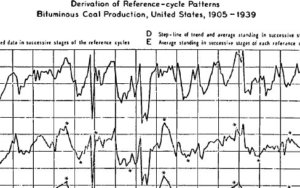In an effort to control the process, several scholarly oriented institutions, including the Social Science Research Council and the American Council of Learned Societies recommended the establishment of “a national agency for the registry and procurement of scientific personnel.” Christened the National Roster of Scientific and Specialized Personnel, the governmental organization set out to send a general questionnaire and a disciplinary “technical check list” of subject matters to all scientists in the country. Each researcher was to provide some personal data and choose a series of subjects he had expertise in, and this information was to be recorded on a punchcard. Upon a public body’s request for specialized personnel, punchcards were sorted with the machine below, so as to identify the scientist with the most adequate skills.
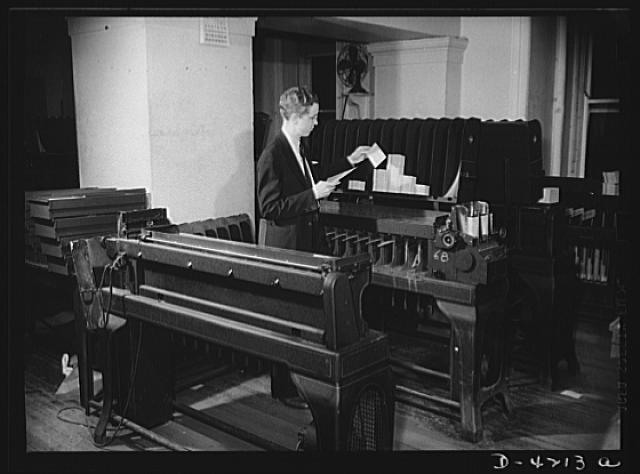
Princeton psychometrician Carl Brigham, the inventor of the SAT, was entrusted with writing up the economics checklist, a task that he found arduous. “I must urgently request that you give your immediate attention to this problem,” he wrote AEA secretary James Washington Bell in October 1940; “all other checklists … in the social sciences have been completed except that for economists and yet the location of specialized personnel in this field would be of utmost importance in national defense.” As Brigham turned to the AEA for help, he was overflowed with classification proposals. Its Executive Committee had just decided to revise the classification for literature Davis Dewey had devised for the first issue of the American Economic Review, issued in 1911. Updated on a case-by-case basis, it featured unsorted headings such as “Agriculture, Mining, Forestry and Fisheries,” “Manufacturing Industries” or “Trade, Commerce, and Commercial Crises.” It was also hoped that such a logically ordered classification could be used to make the structure of the association’s Handbook more navigable. The 1938 edition had listed AEA members alphabetically, while fitted neither researchers’ nor government and business recruiters’ needs.
Proposals ranged from Dewey’s list of 36 unsorted subject matters – designed primarily to identify potential book reviewers – to secretary Bell’s comprehensive and logically ordered scheme, one explicitly designed to emulate the genus-species biological taxonomies developed by Linnaeus during the XIXth century. Most proposals opened with some kind of theoretical/general category, yet two blocks of fields competed for the second tier: the conventional ” Natural and Physical Resources of Production,””Labor,” and “Business” or “Industrial Organization” group reflective of the classical interest in production and allocation was challenged by the “Business Cycles,” “Public Finance” and “Money and Banking” set of subjects characteristic of the rise of a Keynesian focus on exchange and money.
The Executive Committee couldn’t reach any agreement, except against Bell’s proposal, deemed too complex. Brigham concurred. “The purpose of the Roster does not demand a clean-cut, logical system of classification,” he wrote to Bell. Rather, the technological and use constraints of the government and military client should be allowed to frame its structure: “a high degree of refinement does not lend itself to the punched card system. We must … disregard to some extent certain highly analytical concepts,” he explained. Working from the perspective of suppliers as well as demanders of specialized personnel, Brigham decided to fashion two classifications. One, designed with the help of new AER editor Paul Homan, was intended as a list of 200 generic problems studied by economists, from plant locations to producing chemicals, union organization, city planning, crop estimates and radio broadcasting.
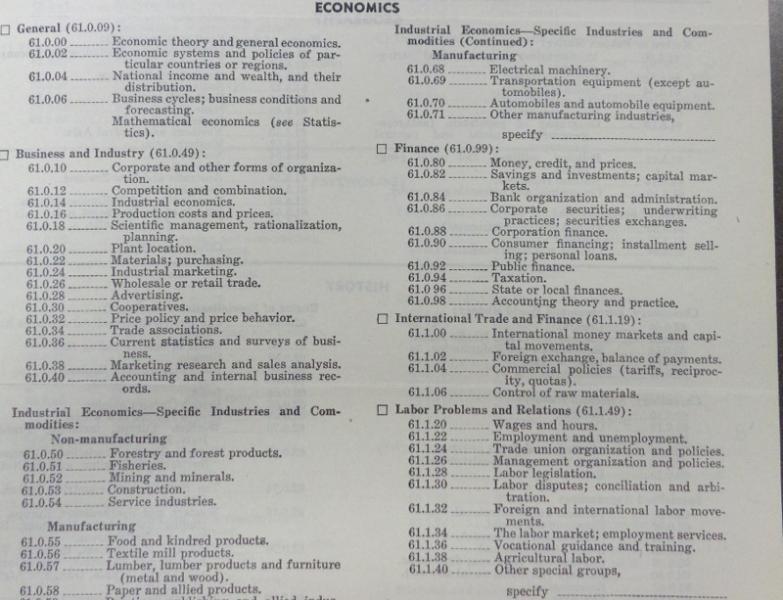
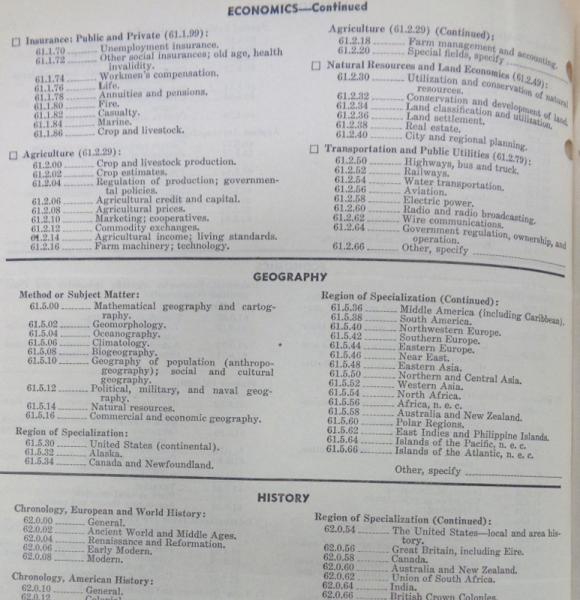
The other one was a list of commodities and manufactured articles which included poultry, potatoes and corn to wool, flax, petroleum, zinc, fertilizers, alkalines, explosives, drugs and machineries. Each economist would pick as many commodities as possible “within the restrictions of a two-column punch,” and, for each one, would specify his principal “method of attack” from a list of ten entries, including extraction, manufacture, transportation, marketing, pricing, wages.
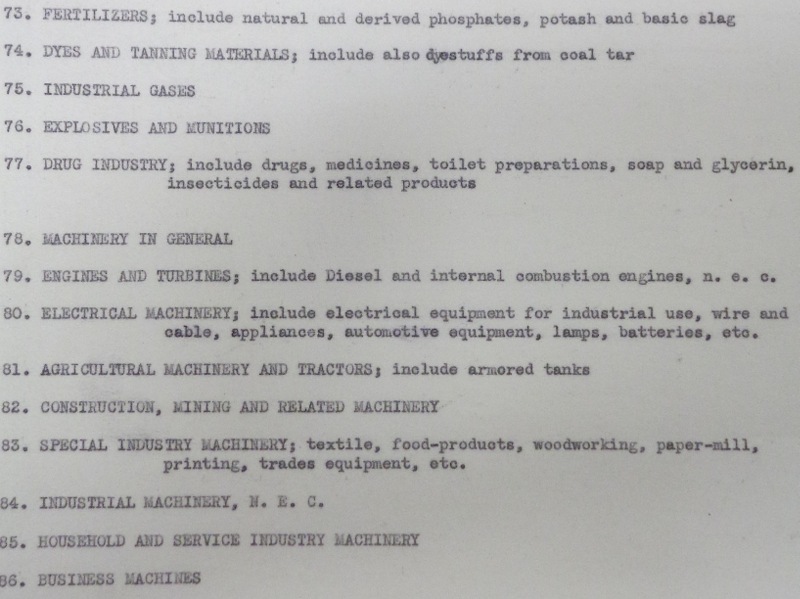
While economics may have emerged from the war as the science of decision, it thus clearly entered it as the science of production, which made it a “critical occupation” alongside psychology and statistics. 4000 questionnaires were sent to economists, among whom 1900 responded. Although secretary Bell was surprised by the large percentage of returns, it was 1000 less respondents than psychologists (to whom 3700 were sent) and only slightly more than statisticians (responding to 3000 requests).
AEA executives, who had hoped to reuse the Roster’s classification once completed, were disappointed by its structure. Aimed at the quick retrieval of scientists’ profiles, it was “simple, logical, but not comprehensive.” In 1942, they consequently devised a new scheme: each of its 20 categories included a set of subheads, although not arranged in a hierarchy, as Bell would have liked. But in 1944, when the Roster asked him to provide a description of the “economist” profession, he carved out a very simple classification with only seven categories: Economic Theory, Money, Banking and Finance, Industry, International Trade, Agricultural Economics, Labor Economics, and Socio-Economics. Aimed at a large audience of non-academic recruiters, it described each branch in simple terms. Those economists working in “Socio-Economics,” for instance “stud[y] broad developments as they affect the economic welfare of the country. This includes such subjects as population growth and movements; national income by social group; the occupational distribution of people; the conservation and use of such natural resources as minerals, water power and land; and regional planning.” The leaflet was introduced by an occupational summary which, again, made it clear that the rationale behind this list was a definition of economics as the science of production.
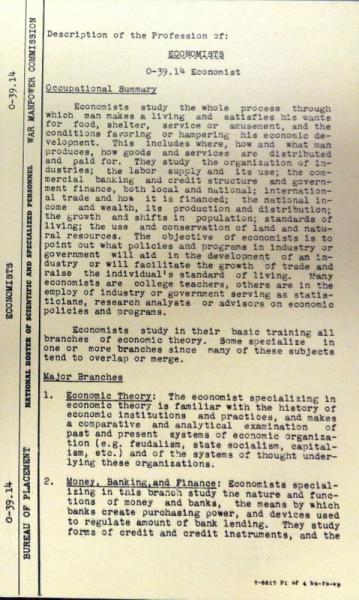
Just like Brigham,secretary Bell was thus well aware that different types of classification were needed for alternative uses. Unlike his psychologist colleague, he was however caught between the contradictory requirements of a variety of clients, and the desire that the AEA classification for literature and personnel adequately reflect the nature and scope of economics. In the next decades, the transformation of the discipline and of its clients would throw AEA executives into increasingly heated classification debates ( to be continued)
Credit: American Economic Association Records, David M. Rubenstein Rare Book & Manuscript Library, Duke University. Permission to quote and to reproduce pictures for non commercial use has been granted by the research services coordinator.



